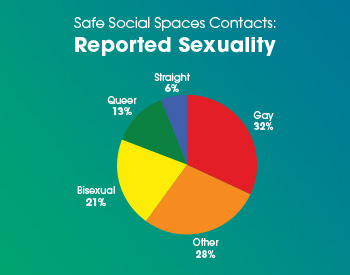Queer people have found community online since the internet started. YouthLine’s Safe Social Spaces, a social media outreach program, is not a specifically queer program, but most of our contacts are queer. Many of our contacts don’t feel like they have a community in person or have families who aren’t helping them access affirming services.
They’re reaching out for acceptance – for people who understand.
YouthLine Social Media Emotional Support Specialists go onto different social media apps – mostly mental health apps – and reach out to youth who are posting about mental health crisis, self-harm, and suicide. Support specialists offer to listen and direct them to resources.
Our conversations are similar to those we would have on the crisis lines, but we are reaching out to people who may never have found or used our services.
To date, the project has reached out to over 1,600 youth, connecting with 930 of them.
We didn’t start the program intending to focus on queer and trans youth, but it has become clear that we’re supporting so many with this program that it’s important to acknowledge.


Two-thirds of contacts reporting their sexuality identify as LGBQ, while nearly 1 in 5 identify their gender as trans or non-binary.
LGBTQ young people – particularly those with multiple marginalized identities, including LGBTQ youth of color – are at significantly higher risk of suicide, substance use, and self-harm than their heterosexual and cisgender peers.*
I’m connecting with youth that are going through things – some of which I have experienced as a queer person myself, and some things I definitely haven’t experienced – and it feels like I can give understanding and support that they may not be getting elsewhere.
As a teen, people around me told me repeatedly that being queer is an acceptable, lovely, beautiful identity, but it was alongside all these other societal signals that maybe it’s bad and wrong – and that’s a hard kind of confusion to grapple with when you’re questioning yourself.
Even though I came from a really accepting family and had an easier time than most people when it came to looking for support, I still struggled a lot coming to terms with the fact that I was queer.
Many people aren’t going to reach out to a helpline or are not able to connect to resources in person. Because they are posting online about their struggles, we’re reaching out to them – and these youth may have never reached out otherwise if we hadn’t reached out to them first.
Often, chatting with one of us is the boost someone needs to reach out to a helpline.
* Please note that LGBTQ young people are not inherently prone to risk because of their sexual orientation or gender identity but rather placed at higher risk because of how they are mistreated and stigmatized in society.
Explore Resources for LGBTQ Communities
- The Trevor Project
- 24/7 Crisis and support line for LGBTQ youth up to age 24
- Call 1-866-468-7386 or learn more about text, chat, and other ways to get help
- Trans Lifeline
- 24/7 peer support and crisis line by and for transgender people
- Call 1-877-565-8860 or learn more about what they offer
By Gen, Social Media Emotional Support Specialist

